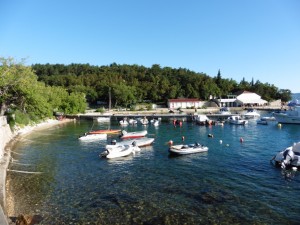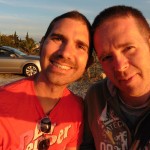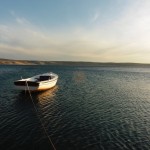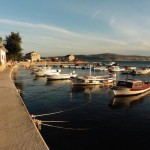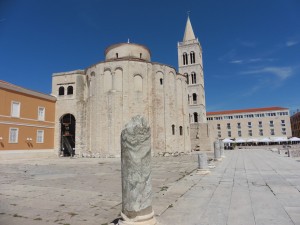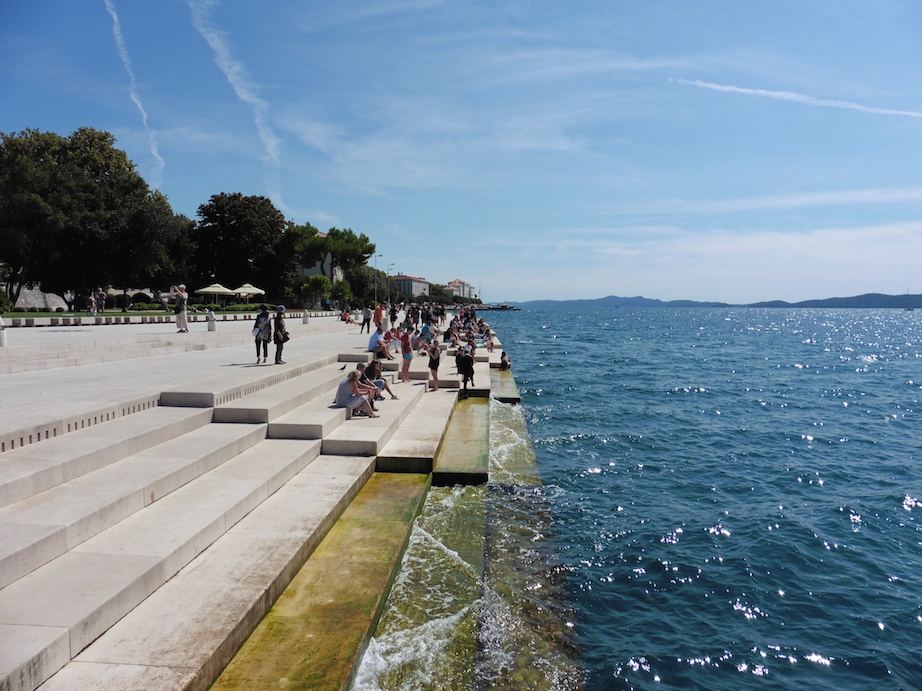Croatia

As Croatia is not part of the Schengen Agreement, for the first time since we’d left the UK, we had to show our passports to an official as we crossed the border. Our first stop was a camp at Rovinj, part of a huge holiday village that was so big it was very easy to get lost in. Swimming in Croatia is thwarted by the need for jellyshoes to avoid urchins (not essential, but advisable) and the craggy shoreline, which means a lot of beaches are just rocky slopes into the water.
Two nights at the camp proved to be enough, as August turned to September, and the families all packed up, the hugeness of the place and distance to walk to everything (including usable wifi) rendered it unworkable, so after a second night we moved down the coast to Pula, where we found a smaller, simple campsite on a jut of coastline.
The swimming issues were still partially in place, but the water was enterable without fear of treading on something spiky due to its clarity and the boats moored up that meant the sea floor was smoothed over. Here, I finally got to revisit Scuba diving for the first time since Thailand in 2012. Though the instructor informed me in no uncertain terms not to expect anything on the same scale, I was, as ever, astonished just to be able to breathe underwater, and we found an Anemone with scores of tiny florescent fish living on it.
When we left Camp Runke after five nights, we drove into Pula with the intention of seeing the famous mini-Colosseum, as Rome was off the table due to mileage and Andy’s previous experience of driving in it (“don’t bother!”) Technically we saw it, though as it was a Saturday and there was a festival on, screwed if we wanted to stop!
So we headed around the corner, hugging the coastline, in the general direction of Zadar and Split, stopping for two nights at Selce, an adorable town with boats moored up along a gorgeous promenade, winding down from the season. The campground we chose, as seemed to be the case with many in the country, was on an incline and difficult to level the van effectively, but the surroundings made up for it.
Upon departing Selce, we embarked on a long day of zig-zagging coast road. The optimistic nav system estimated about two hours, but the hairpin bends and speed limits that rarely went north of 50kmh slowed things down a lot. Every corner was home to an unspoiled turquoise bay, or a tiny clutch of houses, backed by the looming cragginess of the mountains and, across each bay, any of Croatia’s thousands of islands, looking aridly lifeless from afar, but every now and then a town would appear nestled in a cove.
We camped at another hillside location, with pitches rammed between trees at all sorts of odd angles and the nearest thing to a beach so far. The water was still clear, allowing us both to snorkel around looking at the sizeable fish that ventured close to shore.
By this point, we were having to make a decision on a trip back, as the insurance had capped our mileage, if we continued further south to Split, without a ferry crossing to Italy, we’d be cursed with driving the entire length of the country twice.
In Zadar, the next day, we looked into the ferry timetables and the only options were 10-hour overnight crossings, fine if you were allowed anywhere but the deck with a dog. So we explored Zadar’s attractive harbour area, sat on the musical steps (wind and water create a pan-pipe sound), got up close to Roman ruins, and meandered up and down the narrow lanes of olde.
We spent another couple of nights at the camp and made our decision to call time on Croatia after 11 days, and begin the daunting 1,500km, six-day drive back to Spain, where the weather was still like a pristine British summer…
As it turned out, no sooner had we crossed back into Slovenia, the refugee crisis effectively closed Croatia’s borders, resulting in huge waiting times at all crossings.


